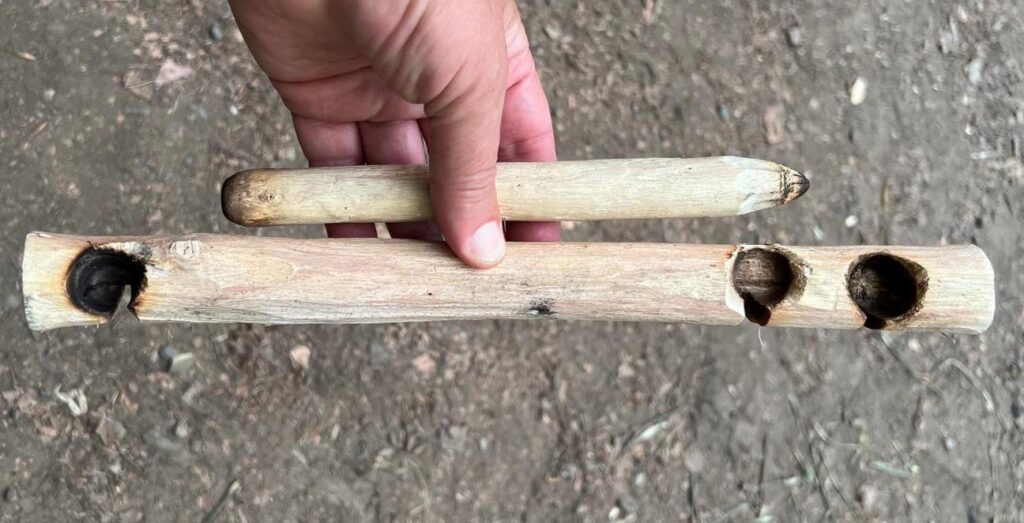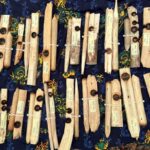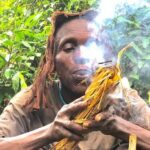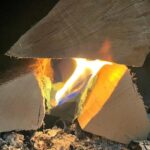At the Global Bushcraft Symposium 2022 in the UK, Gordon Dedman presented a variety of types of Australian friction-fire wood, which are well suited for friction-fire lighting methods and tinder. The signature friction-fire method, exclusively used for thousands of years in Australia, was and is the hand drill. In addition to hand drilling, the fire saw dates back to ancient times in Australia. Bow drills were only introduced very recently by bushcraft enthusiasts from the West.
For hand drill hearth boards and spindles, typically the same wood species, even from the same tree or shrub, should be used. The best wood for hand- and bow drill methods is medium to hard wood, which leaves a clear imprint when scratched with the thumbnail.
Coastal hibiscus wood for friction fire lighting
The best available Australian friction firewood is Coastal hibiscus (Hibiscus tiliaceus), which has many other common names. The wood is uniformly dense and lightweight but still firm. Besides fire lighting, it was also used in former times as a replacement for bottle corks, fishing net floats, and others. The bark was and is used for strings and ropes. Next to Hibiscus tiliaceus, there are about 100 other species of the genus Hibiscus native to Australia, and all of them have suitable friction fire-lighting woods.
Grass trees wood for friction fire lighting

Grass trees (Xanthorrhoea spp.) comprise around 30 different species in Australia. All of them develop long, straight flower spikes. This was already discussed in the post about ‘Spear shafts’ in Australia, which is linked here. This post mentioned that these shafts are used for hearth boards, spindles for friction fire methods, and old flower stalks and fruits for tinder.
It must be added that grass tree spike wood is exceptionally light and stringy. It loses its strength immediately after contact with water. Therefore, when using a grass tree spindle for a bow drill, the bearing at the holding block should never be wetted. Means: Don’t spit into the bearing hole for lubrication, as this will disintegrate the spindle point within the bearing.
Due to this light wood, there is one more necessity. The friction at the contact area should NOT be increased by increasing pressure but by increasing the speed of turns. So, the bow has to be used in a swift stroking action, and for hand drills, it needs a very high rubbing speed, making it a wrong choice.
As grass tree hearth boards and spindles wear quickly, cutting away the charred sides of the drilled hole in the hearth board after burning-in is necessary to reduce sidewall friction.
And just for interest purposes: Grass tree wood emits a distinctive smell from its smoke—more than any other Australian friction firewood.
Red-flowered Kurrajong wood for friction fire lighting
Another Australian friction firewood is from Red-flowered Kurrajong trees (Brachychiton megaphyllus). These trees are easily recognized when all other plants are shedding their leaves. The red Kurrajong flowers stand out in all these yellowish-brown areas. Also, the pods with edible seeds are very conspicuous. These are big black split-open pods with seeds reminding one of yellow corn inside. Kurrajong wood is hard to drill with. It will need a higher pressure to light a friction fire, but the sticks will also hold up longer for future use.
Yellow Kapok wood for friction fire lighting
Yellow Kapok (Cochlospermum fraseri) is very easy to spot in nature due to its unique fruits, filled with dense, white fibers. That’s also an excellent primary tinder in a ‘bird’s nest’. It also has large, yellow, edible flowers that taste pleasantly like butter.
After cutting shoots from Yellow Kapok, the wood should be dried for about ten days. The wood contains lots of knots. It is not as easy for friction fire lighting as the woods mentioned before, as it is harder than other woods. Therefore, both force and speedy twisting are needed on the block.
Hyptis weed stems for hand drills.
Australians also call this invasive species ‘Horehound’ (Hyptis suaveolens). This is an annual or perennial weed with a minty aroma growing up to 2 meters high. Its stems are straight, triangle-shaped, and quite firm when dry but have got knobs, which should be smoothened before use. It also has a relatively large pit inside the stem.
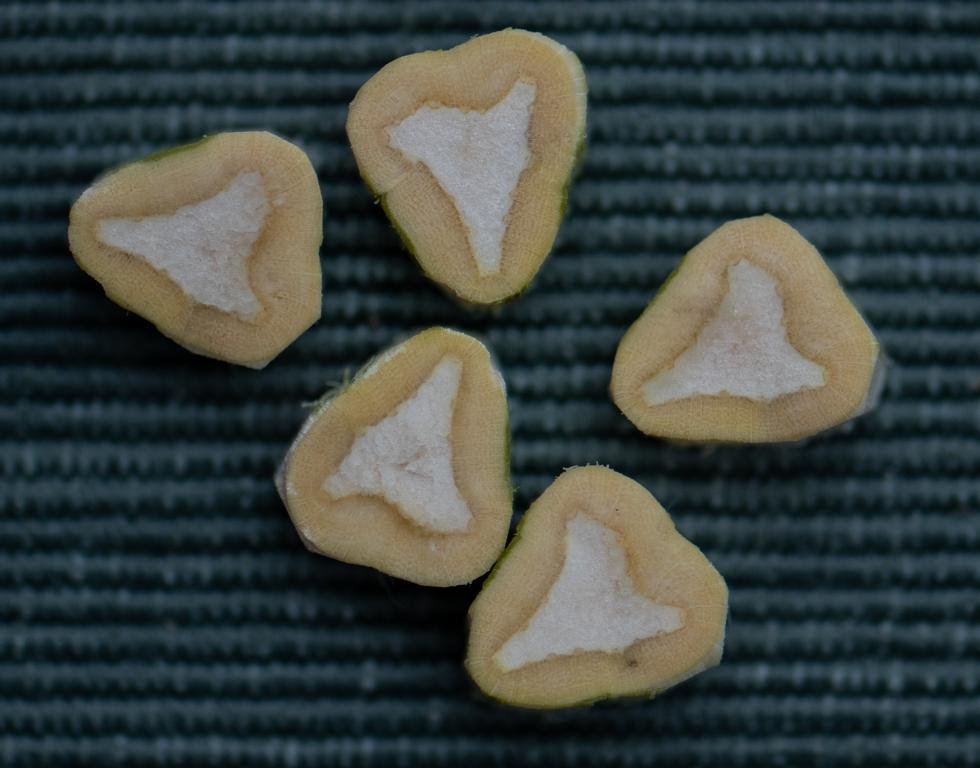
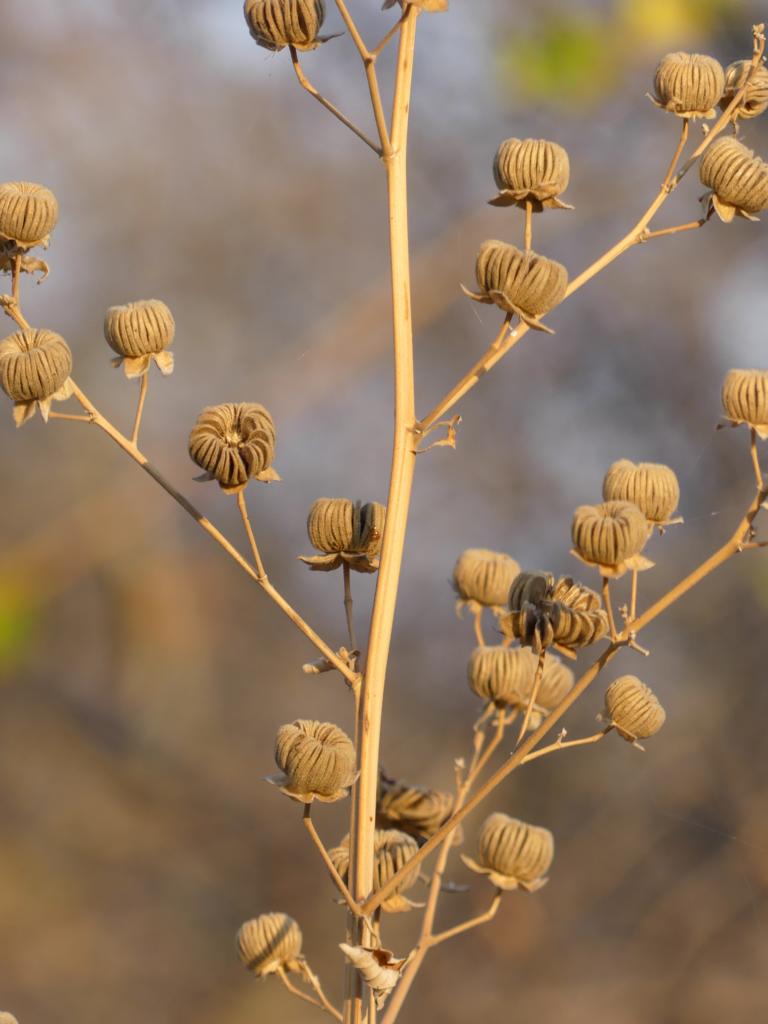
Lighting a fire with a Hyptis spindle is the most challenging job compared with other Australian friction firewood types. It needs pressure, speed, and hard skin on the hand palms. But it is readily available in all northern parts of Australia.
Auxiliary pieces for friction fire lighting
Typically, a stiff, dry leaf or a piece of bark is set underneath the notch to catch the ember from either hand or bow drill actions. Paperbark (Melaleuca quinquenervia, commonly known as the broad-leaved paperbark) is the predominant material used due to its wide availability and pleasant haptic grip.
A green piece of hardwood is necessary for hand drills as a holding block; this could be any Acacia species in Australia.
Processing grass for Tinder
Various dry grasses, especially spear grass, are commonly used for tinder. These grasses are usually pretty coarse, but they must be processed by vigorously rubbing and twisting between both hands. This sounds easy, but it is hard and painful work, as thorny blades and other stingy particles are often inside the grass bundle. This work demands hard skin on the hands. Rubbing grass bundles between both hands and twisting it around is not recommended for office warriors with soft hand skin. Gordon mentioned that their hands, which have not buffed up grass for two weeks, are getting too soft.
After sufficiently buffing up the grass bundle, a depression should be formed inside, sprinkled with another tinder. Tinder’s – other than grasses – used in Australia are very varied:
- Fibrous husks of various species of Cabbage tree palms (Livistona sp.),
- Stringy bark of various Eucalyptus “Stringy barks”,
- Paperbarks (Melaleuca sp.),
- Dead, buffed-up leaves of Matt Rush (Lomandra longifolia),
- Various fluffy seed pods include Cumbungi (Typha sp.) and Kapok’s.
- Also, powdered kangaroo droppings are used.
Pandanus husks for transporting fire
For transporting glowing coals from one place to another, screw-palm (Pandanus sp., P. tectorius, P. spiralis, …) fibers are utilized. They have a thick layer of deposits on the fiber surface composed of lignin, hemicellulose, wax, and pectin. This protects the cellulose fibers in the core and keeps the fibers glowing for a long time.
Lessons learned from Gordon about Australian friction firewood
- The best wood for friction fire lighting is from Hibiscus species, especially Coastal Hibiscus.
- Grass tree spikes, Kurrajong, and Kapok wood are also widely available.
- If nothing else can be found, there is still Hyptis weed for fire drills.
- Grass has to be buffed appropriately up before being used in tinder bundles.
Global Bushcraft Symposium 2022 (GBS2022) and Gordon Dedman
GBS2022 was held from 27th-31st July 2022 at Llyn Tegid (Bala Lake), within Snowdonia National Park, in North Wales, UK.
Gordon Dedman founded Bushcraft Survival Australia (BSA), an outdoor bushcraft survival school dedicated to teaching genuine and authentic modern and traditional outdoor living skills through carefully designed educational courses. He is a former Australian Army 1st Commando Regiment member and a survival instructor in NORFORCE, an Australian Army Reserve Regional Force Surveillance Unit (RFSU). NORFORCE conducts patrols in the remote areas of Northern Australia, working closely with Aboriginal communities. Gordon is also a Combat Survival SERE instructor (Survival Evasion Resistance Escape) and regularly instructs on RAAF Combat Survival Training School Courses in North Queensland.
He has trained at and completed numerous Survival and Bushcraft courses and certifications worldwide at leading schools run by Paul Kirtley (Frontier Bushcraft UK), Ray Mears (Woodlore Bushcraft UK), Dave Canterbury (Pathfinder School USA), Lofty Wiseman (Trueways Survival UK), Richard Hungerford (Bushlore Australia QLD) and Bob Cooper (Bob Cooper Outback Survival WA).
Gordon works seasonally as an outdoor guide in the Northern Territory, taking clients on camping expeditions into Kakadu and Arnhemland. A full bio of Gordon Dedman can be found here. Gordon’s YouTube channel also has videos in various parts of Australia doing friction-fire and using various Tinder, which can be found at this link.
Gordon reviewed this post on August 12, 2022, suggested some changes, and had no further objections.
Further readings about Fire-making on this website:
Creating fire with a magnifying glass
Hadza hand drill friction fire
Bow Drilling – following the method of Mattias Norberg
Giant Fennel stalks for lighting fire
Batwa pygmies traditional fire lighting method
Manketti wood for friction fire lighting
Bushscout UK’s fire bundle basket
Fire lighting with Flint & Steel
Hand drilling in UK as taught by Dave Watson
Bow drill standard procedure by Dave Watson
Bow drilling in Australia by Gordon Dedman
Hand drill friction fire lighting in Australia
Creating fire by hand drill in Namibia
.

